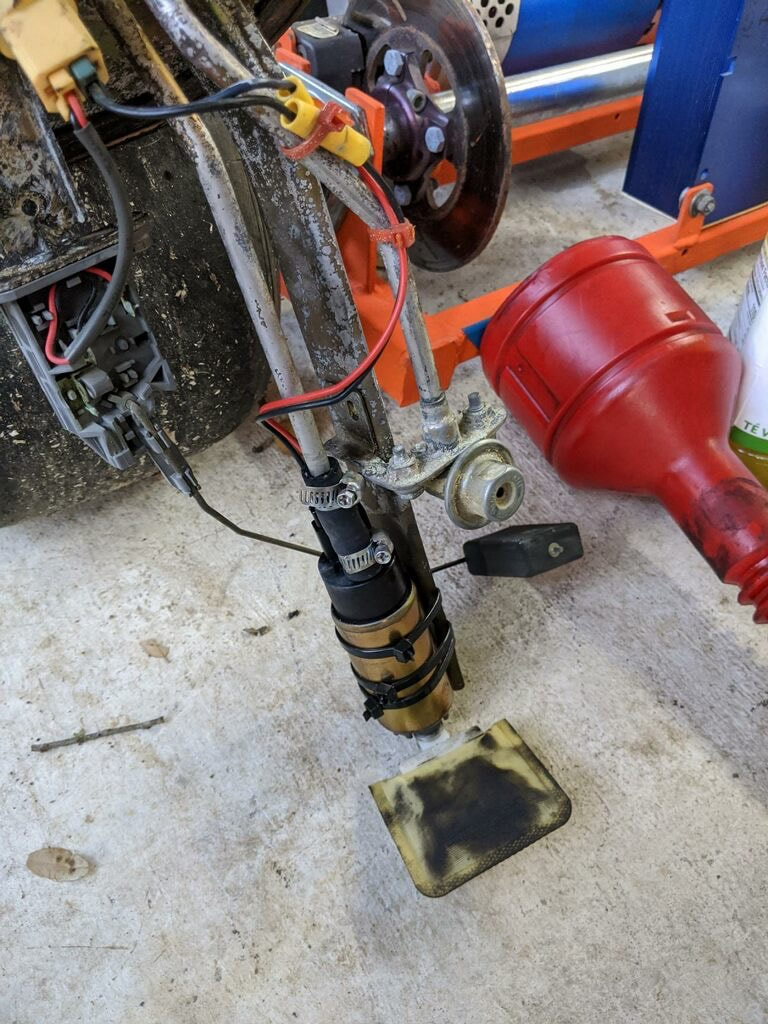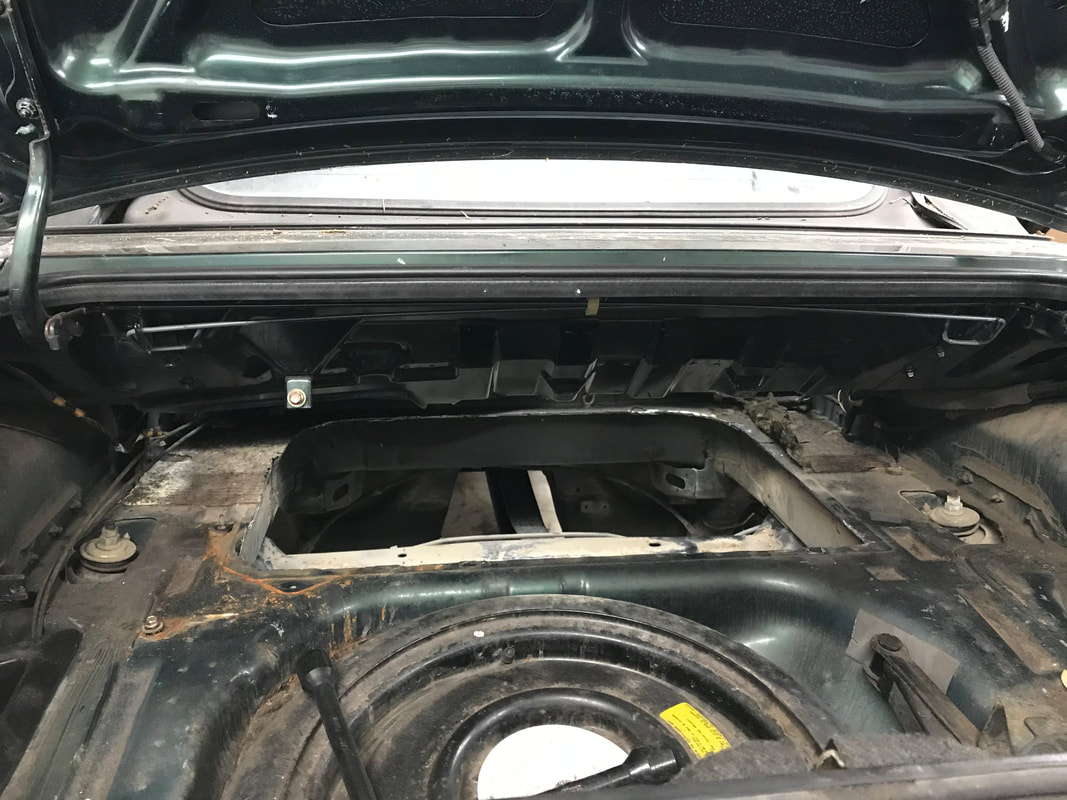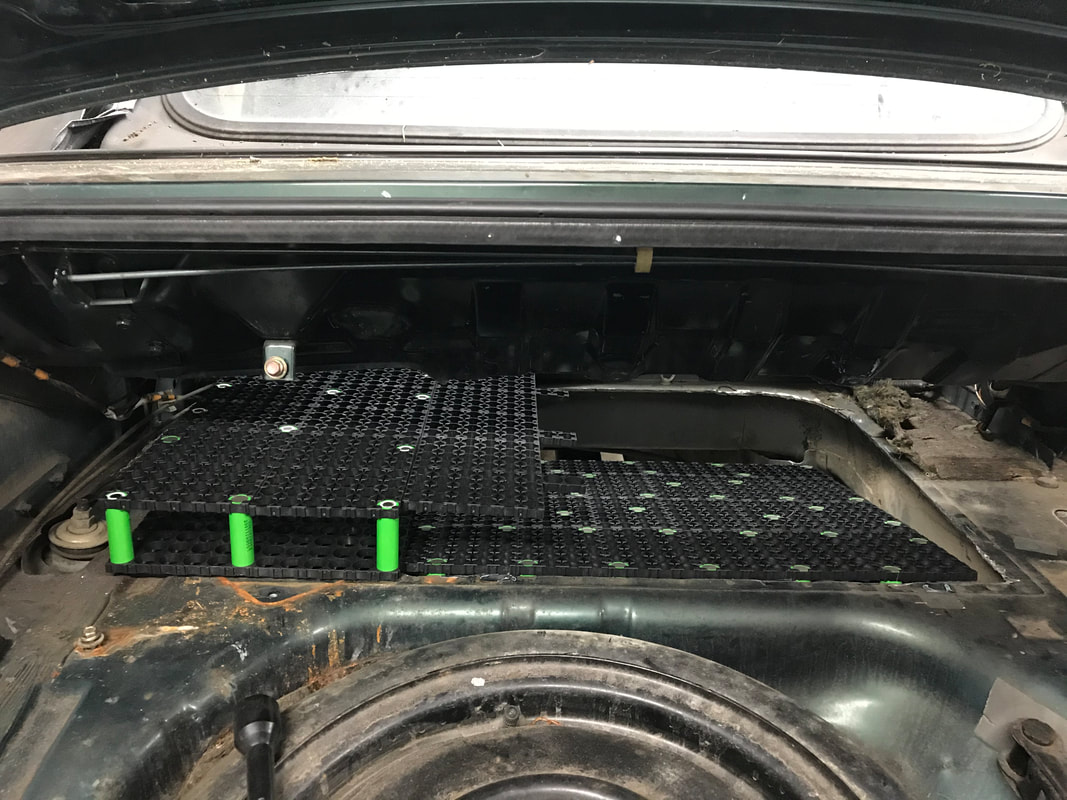|
Fasten your seat belts! Lots of progress happened this week. Finally, it was time to remove the gas tank! The goal was to find out where batteries could fit and how many car modifications were needed to make this happen. While there are other challenges to an EV conversion, battery placement and mounting is one of the larger ones. Using the starter motor, I backed the car in the garage, and jacked up the back as high as my truck jack stands would go. Sprayed some degreaser on the drive train and waited for the the first layer of grime to drip off a 220,000 mile car. I started by removing the rear brace bar and a 17mm bolt snapped off, leaving part of the bolt and its captured nut welded to the sub-frame. Oh no! Is this how its going to be for the rest of the car?? Yikes. I could easily catastrophize this one bolt breaking to having every other bolt breaking and having a large worthless mess to clean up. Luckily, all the other rear-brace bolts came off fine and both my brother and Brian have welders so a welded nut/broken bolt can be fixed. Lets keep going and find out if there is any other bad news. I removed a lot of gas line, the charcoal filter and a bunch of purge lines and solenoids. There are a lot of moving parts in the the fuel systems of these modern autos. I was surprised at how much the charcoal filter weighed. Kurtis was in town, and he volunteered to lend a hand. That's great since getting the sub-frame with differential out looks to be easier with an extra person. As usual, Kurtis jumped in, got greasy and got busy removing everything in the way of the gas tank. There were a few items to note on disassembly. No fluid came out the the transmission when the driveshaft was pulled out. What? On every other car, I usually get a nice dowsing of gear oil when the driveshaft is pulled out? Was the transmission run dry? Does the rear seal leak like a sieve? I need a working transmission for this prototype. I'll have to wait to find out if there are problems as we'll be removing the transmission to mate it with the Leaf motor when a coupler is available. While my mind wandered to possible future problems, Kurtis stays focused on the task at hand and after disconnecting the brake lines and dropping the rear-sub-frame, we can start on the gas tank removal. The tank came out rather easily, once we could get at the lines in the tank rear. The trunk access panel removal with the nearly rusted bolts that could only be turned 1/8th turn at a time was tedious. Once out, we could hear the tank had a little fuel in it and previous hard earned knowledge has taught me how explosive that can be. Thanks Rob! We had removed the fuel pump/sender mount, and emptied the tank. This picture showed us someone had replaced the fuel pump as I'm relatively sure tie wraps weren't stock from Mazda. Thanks Kurtis, for coming over, getting dirty and help advancing the EV dream. The next day, Bruce came over and did some skull sweat on where the batteries needed to go. The energy is different when people are around. I've noticed this both at TaeKwonDo and working on the car. As I 'mature', I find I can really use that extra energy! We created a preliminary plan on where the batteries would mount and the modifications needed to the car. Rather than assume we had the best plan, we decided to consult with Brian. He had contributed to the Pantera frame reinforcement project and was a great help there. He happened to be available and came over to join the fun. After looking at all the parts he agreed with our assessment of the back battery mounting and then had some ideas about battery placement in the front. We did attempt to test fit batteries under the floor on the passenger side and decided against it for prototype version 0.5. The important thing at this stage is to get the prototype running so we can learn what we didn't know we needed to know. So we're prepared to sacrifice a little bit of performance for ease of installation and maintenance, knowing we'll do better when we know more. Thanks Brian for helping out! At this point mid-morning, I started feeling poorly. I had gotten so excited I forgot to drink anything besides my morning coffee. That might have been fine had we been working in the AC. I actually noticed Bruce sweating, but didn't really connect the dots that I should be sweating too. I ended up dehydrated which slowed the rest of my day. After lots of water, lunch break and a little rest, Bruce came back with his sons and went to work removing the gas tank holder from the trunk. This will allow us to install 72 of the 96 batteries in the space vacated by the fuel tank. One pack, will be two 16s22p (16 cells in series (s) and 22 cells in parallel (p)) combined for a single 32s22p pack. Combining two packs saves us a space, eliminates two bus bars and one inter pack connection. The larger pack will fit down where the fuel tank used to sit. I attempted to use more of the fuel tank space, but ended up scrapping that idea as it exposed the ends of two packs to road debris thrown up by the tires. Too much engineering for version 0.5. There are two 20s22p packs that fit on top of the larger pack (only 1 shown) taking up the rest of the fuel tank space plus a little bit of empty space. The 24 remaining cells can be split into two 12s22p packs sitting beside the Leaf motor to keep the front weight about the same. We cleaned parts, removed the cruise control, found the piece of block that was ejected when the rod hit the side of the wall. We re-installed the rear sub-frame and at this point I needed the extra floor jack that I had borrowed from my neighbor Andy. Thanks Andy! Another person made a donation to the project and took the gas tank away for re-use in another Miata. A big thank you to Bruce, Eric and Nolan for their help, cleaning, cutting, and doing the heavy lifting. The car was re-assembled enough to get it back to its parking spot.
One of last week's goals was to work on the PID algorithm and tune it well enough to facilitate shifting without a clutch. A video from another Electric Vehicle conversion that uses a Leaf motor indicates that commanding zero torque to the Leaf motor during a shift will allow the transmission to drop into gear. A critical difference is he is using a 60's vintage ford toploader transmission, which likely has much stronger synchronizers than a Miata transmission! In any case, after working on PID (so much nicer to work on code in the AC) for a few days, I came to the conclusion that PID will be good at cruise control tasks, but not so good for a quick transitions like shifting. Investigation into the details of PID helped me find some software issues in my code, which I fixed. So if PID wasn't going to be the best for shifting, what should I do? Plan B was to program a very simple and direct control loop. When a shift is needed, apply full regeneration slowing the Leaf motor until we are close to the RPM needed for the next gear. Then we have to cancel the inertia created from slowing the motor down rapidly and signal the driver it's safe to engage the next gear. In comparison to PID, I was able to achieve the same RPM drop in half the time using the same power and there is every indication I can do it even faster when I have the motor mounted down and the full battery pack (allowing use of more power.. :) ) I'm happy enough with the results to leave the final tuning for when we have the motor and battery in the Miata. Next week's goals are to do some more software design. Detailed PID investigation revealed that I'm close to my message rate limits on the Pi using Python. Being able use more Pi's seamlessly for other tasks is a feature that will be needed for using multiple motors. The other goal is to produce the plastic battery covers that will be used on the prototype packs so a frame can be constructed to hold the batteries. All battery pack sizes are now known and verified. Producing the battery holding frames can be started and that will help when needed to mount them to the car. That also means I can start assembling the large pack which is a non-trivial task. Thanks for reading! I hope everyone is staying healthy and doing something as fun as making an EV.
2 Comments
Arm
6/15/2020 09:28:40 am
Looking good! Will you guys attack the battery cooling problem in this version? Retaining the transmission will be amazing! A single speed gearbox is simple but you don't get the joy of rowing your own gears!
Reply
Bill Bitner
6/15/2020 04:07:42 pm
Hi Arm! We'll be studying the battery thermal characteristics on this version. (no initial heating, although we may have air cooling for balancing). Our BMS boards can measure temperature and we will instrument the packs. The transmission is a simple way to simulate having 1, 2, or 3 motors using the stock differential gearing, and I've always wanted to be able to shift a little faster, lol
Reply
Leave a Reply. |
AuthorBill likes cars that understand the 'go fast now' pedal. Archives
May 2022
Categories |




 RSS Feed
RSS Feed